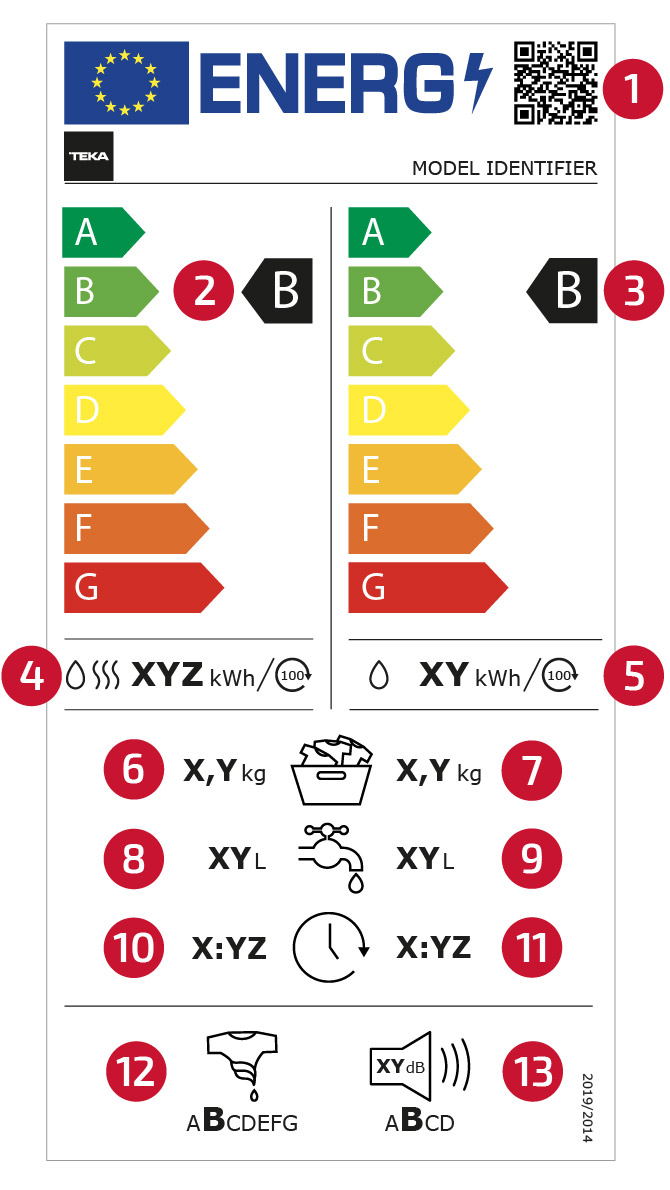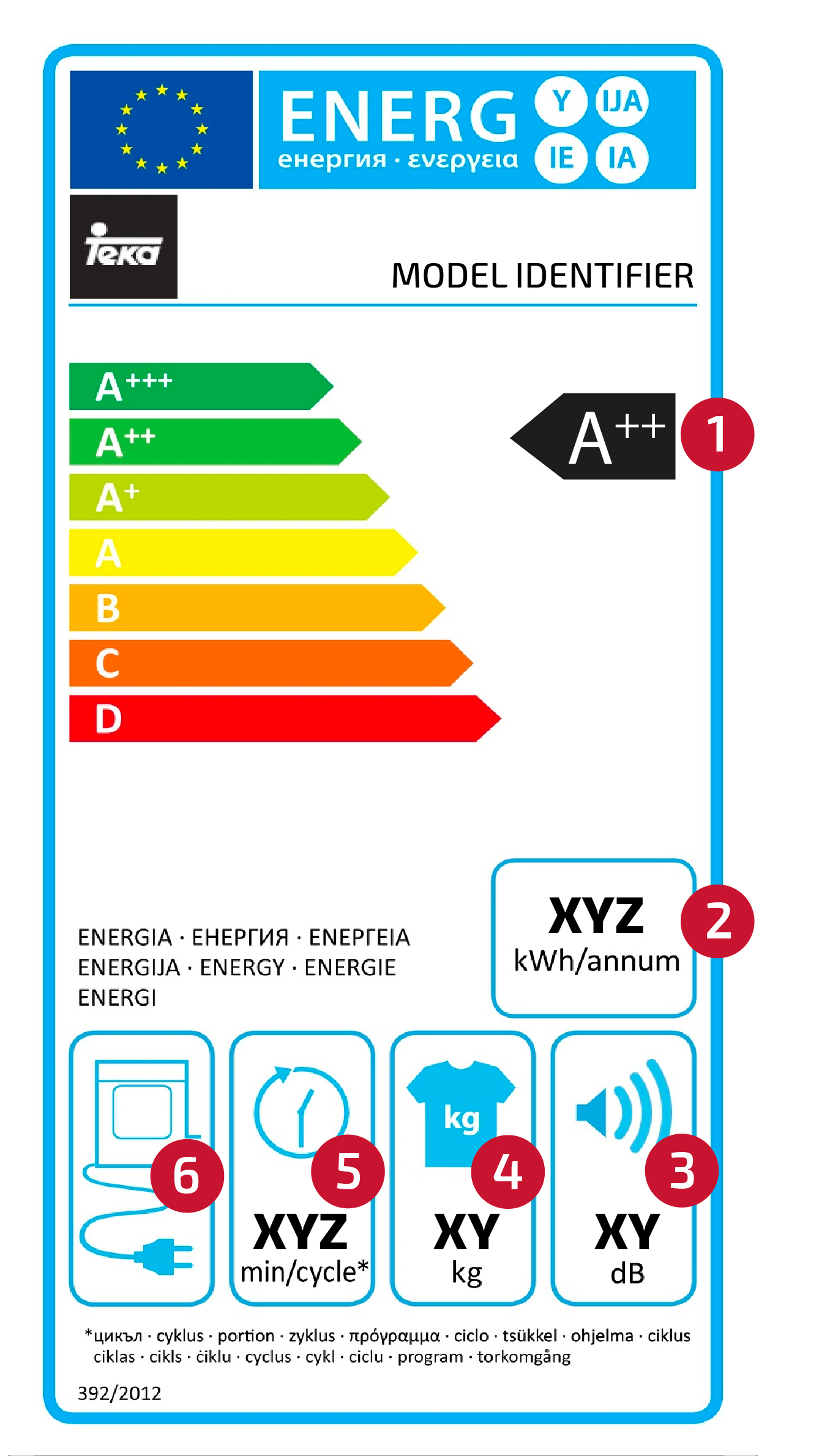New Energy Label for Appliances
From March 1st, 2021, our appliances’ energy label has changed.
In this case, it affects washers, washer-dryers, dishwashers, fridges and freezers.
It is compulsory for these new lines to show the new energy label, online and on physical points of sale.
Why is the energy label changing?
Sustainability is important
Increasingly
Consumers demand higher sustainability levels as well as faster features.
Technology advances
Creating better products
Technology is developing steadily and so is impacting the appliance industry.
For that reason, appliances with an A+ energy efficiency class and even higher are being produced, which implies that the energy label has become obsolete and has lost its utility.
Greater precision
In technical reasons
The testing method used to acquire the information displayed the energy label needed a change.
What will change in 2021?
The most important change will be the disappearance of A+, A++ and A+++ energy efficiency classes. Instead, a new rescaling from A to G will take place. However, this will only mean a letter change, as this will not translate into an increase in the appliance’s energy consumption.
For you to be able to access all the information, the new energy labels will have a QR code that will lead you to a database with all the product sheets affected by this change. Moreover, you will also be able to access this information on the internet.

![Global_mobile[1] fechas cambio etiqueta](https://www.teka.com/global/wp-content/uploads/sites/3/2021/02/Global_desktop1.jpg)
See new labels
displaynone
Washers’ new energy label
Regarding the new labeling, the changes will be in the design as well as in the content and the information displayed. Moreover, it will be given more emphasis to the new program “Eco 40-60” which is perfect for cotton, linen or mixed clothing as long as they can bear the temperature according to their label and they have a standard level of dirtiness.
Information that will be showed in the new label:
- QR code
- Energy efficiency label**
- Energetic consumption weighted average** in kWh/100 operating cycles (in the Eco 40-60 program)
- Maximum load capacity
- Program duration “Eco 40-60”
- Water consumption weighted average** in liters/cycle of operation (in the Eco 40-60 program)
- Efficiency class for centrifugation**
- Sound power during the centrifugation cycle expressed in DB(A) re 1 PW and noise emission class**
** These values apply to a quarter capacity loads, medium or complete loads.

Washer-dryers’ new energy label
In the new labeling, the scale range from A to G will remain. However, the label will be divided into two columns. On the left, the values for the complete operation, meaning for washing and drying. And on the right column, only for washing.
Information that will be showed in the new label:
- QR code
- Energy efficiency label *(complete operating cycle)
- Energy efficiency label (washing cycle)
- Energetic consumption weighted average * in kWh/100 cycles(complete operating cycle**)
- Energetic consumption weighted average * in kWh/100 cycles (washing cycle)
- Maximum load capacity (complete operating cycle**)
- Maximum load capacity (washing cycle)
- Water consumption weighted average* in liters/cycle of operation (complete operating cycle**)
- Water consumption weighted average* in liters/cycle of operation (washing cycle)
- Program duration operation (complete operating cycle**)
- Program duration “Eco 40-60”
- Efficiency class for centrifugation*
- Sound power during the centrifugation cycle expressed in DB(A) re 1 PW and noise emission class
* These values apply to a quarter capacity loads, medium or complete loads.
** Washing and drying

Dishwashers’ new energy label
In the new label, the Eco program will still be a reference for values. However, the testing method used to acquire the information has changed and it will be based on 100 cycles:
Information that will be showed in the new label:
- QR code
- Energy efficiency label
- Energy consumption in kWh/100 operating cycles (in the Eco program)
- Standard dish capacity (for the Eco program)
- Water consumption in liters/cycle operation (in the eco-program)
- The “Eco” program duration
- Sound power expressed in dB(A) re 1 PW and noise emission class

Fridges and freezers’ new energy label
Information that will be shown in the new label:
- QR code
- Energy efficiency class
- Energy consumption in kWh/year (measured according to the new standard conditions)
- Total room of all the freezer’s compartments
- Total room of all the fridge’s compartments
- Sound power expressed in dB(A) re 1 PW and noise emission class

See labels with no changes
displaynone
Ovens’ energy labe
Ovens’ energy label shows its interior load capacity and its consumption for the different models during two types of cooking:
- Hot steam cooking
- Cooking with superior and inferior heat
- Energy efficiency class
- Energy source: electricity
- Cavity capacity
- Energy consumption in kWh/cycle (superior/inferior heat)
- Energy consumption in kWh/cycle (hot heat)

Hoods’ energy label
Hoods’ energy label shows its consumption and its efficiency levels based on a 60-minute daily usage on average and with the light on for 120 minutes.
- Energy efficiency class (fan and lighting)
- Energy consumption in kWh/year
- Fan efficiency
- Lighting efficiency (lighting and distribution)
- Greaseproof filter efficiency
- Sound power expressed in dB(A) re 1 PW

Dryers’ energy label
Dryers’ energy label shows information about its consumption and efficiency, based on 160 drying cycles with the standard program for cotton.
The classification scale is divided from letter D to A+++, being the latter the most efficient reducing consumption up to 63% compared with class A appliances.
Regarding A++ class, it reduces consumption up to 51% and the A+ class up to 35%.
- Energy efficiency class
- Energy consumption in kWh/year (160 standard drying cycles annually)
- Sound power expressed In dB(A) re 1 PW
- Maximum load capacity
- Duration
- Energy source: electricity
- Drying efficiency class

